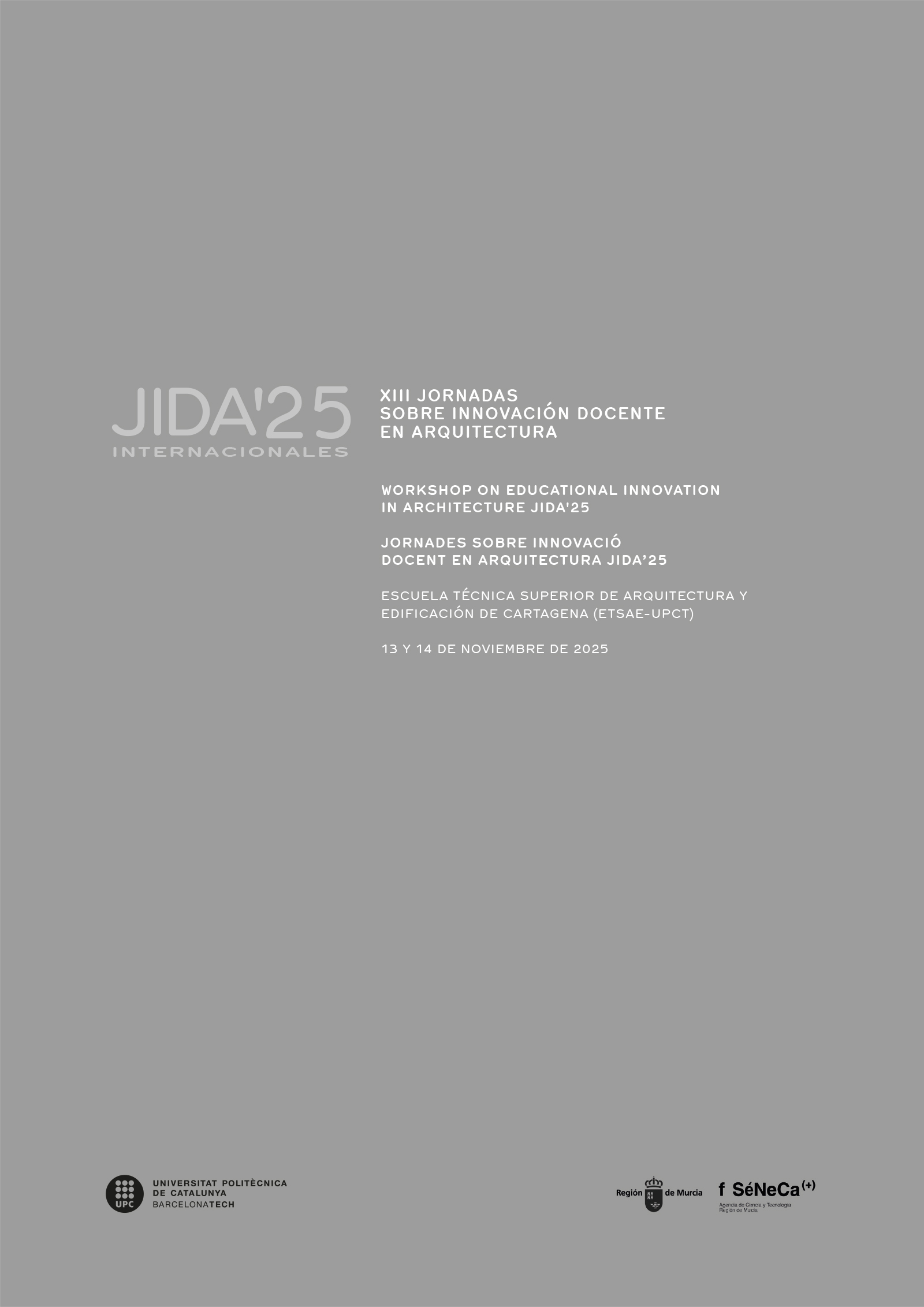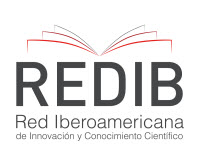Pedagogía de la biodiversidad en Arquitectura: aprender a cohabitar con lo vivo
DOI:
https://doi.org/10.5821/jida.2025.13601Palabras clave:
multiespecie, aprendizaje transdisciplinar, arquitectura biodiversa, pedagogía situada, prototipado proyectual exploratorioResumen
Esta comunicación presenta una experiencia docente en primer curso de la Escuela Técnica Superior de Arquitectura de Sevilla (ETSAS), donde la biodiversidad se plantea como fundamento operativo del pensamiento proyectual. La propuesta entiende el diseño como investigación, adoptando el Research by Design como metodología. El alumnado realizó safaris urbanos, cartografías multiespecie y prototipos concebidos como hipótesis más que como objetos finales. Se generaron más de un centenar de proyectos, agrupados en tres patrones: envolventes vivas, dispositivos interconectores y mediadores. La evaluación combinó rúbricas y cuestionarios, mostrando una progresión desde la sensibilidad ecológica hasta la factibilidad proyectual. La experiencia validó una alfabetización inicial en conciencia sostenible, preparando a los estudiantes a cohabitar y replantear la arquitectura como mediación entre especies, hábitats y futuros ecosistemas urbanos.
Citas
Alexander, Christopher. 1965. «A city is not a tree». Architectural forum 112 (1).
———. 2009. «La ciudad no es un árbol». Boletín CF+S, n.o 40: 113-30. https://polired.upm.es/index.php/boletincfs/article/view/2374.
Alfaya, Luciano, y Carmen Armada. 2020. «Estrategias transversales: el grano y la paja». VIII Jornadas sobre Innovación Docente en Arquitectura (JIDA’20), Escuela Técnica Superior de Arquitectura de Málaga, 12 y 13 de Noviembre de 2020: libro de actas, noviembre de 2020, 208-18. https://doi.org/10.5821/jida.2020.9339.
Alonso del Casar, Judit. 2025. «Pedagogías salvajes: nuevas concepciones para una ontología relacional en educación». Teoría de la Educación. Revista Interuniversitaria 37 (1): 45-63. https://doi.org/10.14201/teri.31881.
Anguelovski, Isabelle, James J. T. Connolly, Laia Masip, y Hamil Pearsall. 2018. «Assessing Green Gentrification in Historically Disenfranchised Neighborhoods: A Longitudinal and Spatial Analysis of Barcelona». Urban Geography 39 (3): 458-91. https://doi.org/10.1080/02723638.2017.1349987.
Archer, Bruce. 1995. «The Nature of Research». Co-Design: An Interdisciplinary Journal of Design, n.o 2: 6-13.
Braidotti, Rosi. 2024. Posthuman Knowledge and the Critical Posthumanities. The Incidents. Cambridge (Mass.): Harvard Design Press and Sternberg Press. https://www.gsd.harvard.edu/publication/posthuman-knowledge-and-the-critical-posthumanities/.
Bryson, Jeremy. 2013. «The Nature of Gentrification». Geography Compass 7 (8): 578-87. https://doi.org/10.1111/gec3.12056.
Childers, Daniel L., Paul Bois, Hilairy E. Hartnett, Timon McPhearson, Geneviève S. Metson, y Christopher A. Sanchez. 2019. «Urban Ecological Infrastructure: An Inclusive Concept for the Non-Built Urban Environment». Elementa: Science of the Anthropocene 7 (enero): 46. https://doi.org/10.1525/elementa.385.
Clement, Gilles. 2004. Manifiesto del tercer paisaje. Barcelona: Gustavo Gili.
Curran, Winifred, y Trina Hamilton. 2012. «Just Green Enough: Contesting Environmental Gentrification in Greenpoint, Brooklyn». Local Environment 17 (9): 1027-42. https://doi.org/10.1080/13549839.2012.729569.
Frayling, Christopher. 1993. «Research in Art and Design». Royal College of Art Research Papers 1 (1): 1-5. https://researchonline.rca.ac.uk/id/eprint/384.
Galí-Izard, Teresa. 2006. Los mismos paisajes: ideas e interpretaciones I The same landscapes: ideas and interpretations. 2. pr. Land & scape series 4. Barcelona: Gili.
García Triviño, Francisco, y Idoia Otegui Vicens. 2022. «Aprendizaje transversal: una arquitectura de coexistencia entre lo antrópico y lo biótico». X Jornadas sobre Innovación Docente en Arquitectura (JIDA’22), Escuela Técnica Superior de Arquitectura de Reus, 17 y 18 de Noviembre de 2022: libro de actas, noviembre de 2022, 450-61. https://doi.org/10.5821/jida.2022.11604.
Haraway, Donna J. 2008. When species meet. Posthumanities 3. Minneapolis: University of Minnesota Press.
———. 2016. Staying with the Trouble: Making Kin in the Chthulucene. Experimental Futures Technological Lives, Scientific Arts, Anthropological Voices. Durham London: Duke University Press.
Just, Johanna. 2022. «Cultivating More-than-Human Care: Exploring Bird Watching as a Landscaping Practice on the Example of Sand Martins and Flooded Gravel Pits». Frontiers of Architectural Research 11 (6): 1205-13. https://doi.org/10.1016/j.foar.2022.04.007.
Latour, Bruno. 2017. Où atterrir? comment s’orienter en politique. Cahiers libres. Paris: La Découverte.
Quastel, Noah. 2009. «Political Ecologies of Gentrification». Urban Geography 30 (7): 694-725. https://doi.org/10.2747/0272-3638.30.7.694.
Riffat, Maria, Blal Adem Esmail, Jingxia Wang, y Christian Albert. 2023. «Biodiversity and Ecosystem Services Dashboards to Inform Landscape and Urban Planning: A Systematic Analysis of Current Practices». Ecosystems and People 19 (1): 2263105. https://doi.org/10.1080/26395916.2023.2263105.
Riffat, Saffa, Mardiana Idayu Ahmad, y Aliff Shakir. 2025. «Eco-Cities: Sustainable Urban Living». En Sustainable Energy Technologies and Low Carbon Buildings, de Saffa Riffat, Mardiana Idayu Ahmad, y Aliff Shakir, 45:259-309. Lecture Notes in Energy. Cham: Springer Nature Switzerland. https://doi.org/10.1007/978-3-031-78853-6_6.
Rosén, Anton Poikolainen, Antti Salovaara, Andrea Botero, y Marie Louise Juul Søndergaard. 2024. More-Than-Human Design in Practice. 1.a ed. London: Routledge. https://doi.org/10.4324/9781003467731.
Schön, Donald A. 2017. The Reflective Practitioner. How Professionals Think in Action. 0 ed. Routledge. https://doi.org/10.4324/9781315237473.
Sheikh, Hira, Peta Mitchell, y Marcus Foth. 2023. «Reparative Futures of Smart Urban Governance: A Speculative Design Approach for Multispecies Justice». Futures 154 (diciembre): 103266. https://doi.org/10.1016/j.futures.2023.103266.
Sloterdijk, Peter. 2009. «Peter Sloterdijk». Environment and Planning 27 (April 1915): 41-58. http://www.envplan.com/abstract.cgi?id=dst1.
Solans Ibáñez, Indíbil, Cristóbal Fernández Zapata, Arturo Frediani Sarfati, y Jordi Sardà Ferran. 2018. «La maqueta como herramienta de proyecto». VI Jornadas sobre Innovación Docente en Arquitectura (JIDA’18), Escuela de Ingeniería y Arquitectura de Zaragoza, 22 y 23 de Noviembre de 2018, noviembre de 2018, 696-709. https://doi.org/10.5821/jida.2018.5546.
Tapia Martin, Carlos, y Carlos Medina Morillas. 2020. «Zoe entra en casa: la biología en la formación en arquitectura». VIII Jornadas sobre Innovación Docente en Arquitectura (JIDA’20), Escuela Técnica Superior de Arquitectura de Málaga, 12 y 13 de Noviembre de 2020: libro de actas, noviembre de 2020, 141-50. https://doi.org/10.5821/jida.2020.9330.
Tsing, Anna Lowenhaupt. 2015. The Mushroom at the End of the World: On the Possibility of Life in Capitalist Ruins. Princeton University Press. https://doi.org/10.2307/j.ctvc77bcc.
Wolch, Jennifer R. 1998. «Zoöpolis». En Animal Geographies: Place, Politics, and Identity in the Nature-Culture Borderlands, editado por Jennifer R. Wolch y Jody Emel, 119-38. Londres: Verso.
Wolch, Jennifer R., Jason Byrne, y Joshua P. Newell. 2014. «Urban Green Space, Public Health, and Environmental Justice: The Challenge of Making Cities ‘Just Green Enough’». Landscape and Urban Planning 125 (mayo): 234-44. https://doi.org/10.1016/j.landurbplan.2014.01.017.






















